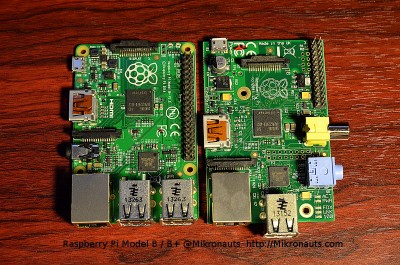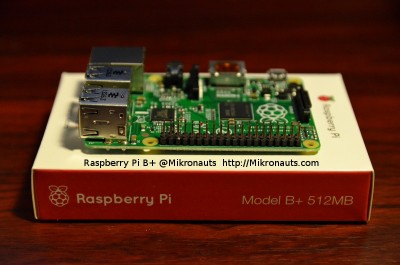Raspberry Pi Model B+ Review
Almost perfect!
That’s how I’d describe the Raspberry Pi Model B+ after evaluating it these past few weeks – if I had to describe it in just two words.
(Click for larger image. Raspberry Pi Left: Model B+ Right: Model B)
If it had more memory, and a significantly faster processor, I would have to call it perfect… but we will have to wait for a future Raspberry Pi for that, as the Model B+ has the same Broadcom BCM2835 processor, with the same 512MB of memory stacked on the processor.
Still, for its intended purpose – a very low cost educational computer for teaching programming to children – it is practically perfect!
The improved power circuitry, four USB ports, proper mounting holes and micro SD slot make a tremendous difference in usability, and the reduced power consumption (due to the far more efficient switching regulator) is icing on the cake.
Sorry if I sound like a “fan boy” – don’t worry, the commentary and the testing is unbiased, this review was not sponsored, I purchased all Pi’s and related equipment – however after spending weeks using the Model B+ I am quite enthusiastic about the improvements. Read this (long) review, and I think you will see why I am impressed. Especially by the power consumption tests!
But I am getting ahead of myself…
Summary of the major changes made by the Model B+
- 40 pin GPIO header (was 26 pins)
- 4 USB 2.0 ports (was one (A) or two (B))
- micro SD card socket (was full size SD slot)
- Switching voltage regulation (was linear)
- Improved audio quality due to separate audio low noise power supply
- Improved board layout
- Ethernet & USB connectors stick out less
- replaced RCA video connector with combined video/audio 3.5mm 4 signal jack
- four proper mounting holes in a nice rectangular pattern
- rounded corners for little fingers
All these improvements for the same $35USD price!
40 pin GPIO header
(Click for larger image. Raspberry Pi Model B+ Upper Left: Model A, Upper Right: Model B)
The first thing you have to know about the new 40 pin GPIO connector is that it is compatible with the old 26 pin I/O connector.
The first 26 signals are the same as before, and most expansion boards will fit. Those that don’t, along with 26 pin IDC cables, can be made to work by adding a stacking header between the old style peripheral or cable and the Model B+
The 40 pin header provides a total of 14 additional pins, which can be broken down as follows:
- three additional GND signals
- two signals reserved for a board identification EEPROM for the new “HAT” standard
- nine additional GPIO’s
(Click for larger image. Raspberry Pi Model B+ 40 pin GPIO header)
More GPIO’s are always appreciated – however we really only get five additional GPIO’s with respect to rev.2 or higher Raspberry Pi Model A’s and B’s, as we lose the P5 connector which previously provided us with four GPIO’s.
Don’t get me wrong – I am not complaining, five extra GPIO’s is a nice bonus!


